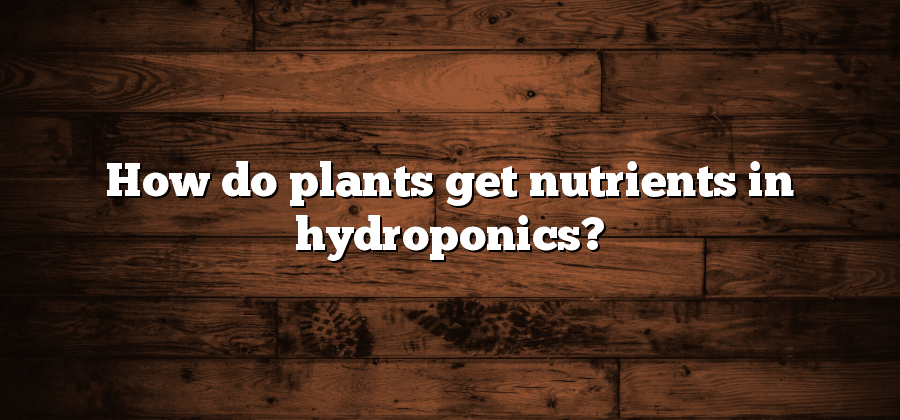The Nutrient Solution in Hydroponics
In hydroponic systems, the nutrient solution is the lifeblood that sustains plant growth and development. This solution serves as a substitute for natural soil, providing essential elements for plant nutrition. Unlike traditional soil-based gardening, hydroponics relies on a carefully balanced mixture of nutrients dissolved in water to supply plants with everything they need to thrive. The nutrient solution is meticulously formulated to meet the specific requirements of different plant species, ensuring optimal growth and yields.
The composition of the nutrient solution primarily depends on the type of plants being cultivated. It typically includes essential macronutrients such as nitrogen, phosphorus, and potassium, along with secondary macronutrients like calcium, magnesium, and sulfur. Additionally, trace elements such as iron, manganese, and zinc are also incorporated to support healthy plant growth. These nutrients are dissolved in water, which acts as a carrier to deliver them to the plant roots. The nutrient solution is continuously circulated through the hydroponic system, ensuring a constant supply of essential elements for the plants.
Absorption of Nutrients by Plant Roots
Plant roots play a critical role in the absorption of nutrients in hydroponics systems. Through their root hairs, they actively seek out and take in essential elements required for growth and development. This ability is facilitated by the finely branched structure of the roots, which greatly increases the surface area available for nutrient absorption.
The absorption process begins as the plant releases organic compounds from its root system. These compounds, known as exudates, attract beneficial microorganisms in the growing medium. These microorganisms, in turn, aid in breaking down complex nutrients into simpler forms that can be easily absorbed by the roots. As the roots come into contact with the dissolved nutrients, they utilize a process called passive diffusion to draw in the essential elements. This process relies on concentration gradients, where nutrients move from an area of high concentration outside the root cells to an area of lower concentration inside the cells. Ultimately, this allows the plant to obtain the necessary nutrients for growth and overall plant health.
The Role of Water in Nutrient Uptake
Water is an essential component in the nutrient uptake process of plants in hydroponics. It plays a crucial role in facilitating the absorption and transport of nutrients from the growing medium to the plant roots. Without an adequate supply of water, plants would not be able to access the essential elements they need for growth and development.
In hydroponic systems, water serves as the carrier for nutrients, allowing them to dissolve and be readily available for absorption by the plant roots. As the roots come into contact with the nutrient solution, water acts as a vehicle, transporting the essential elements through the root system. This process of water-mediated nutrient uptake is crucial for plants to acquire the necessary nitrogen, phosphorus, potassium, and other vital nutrients that support their metabolic functions.
Additionally, water plays a key role in maintaining the proper moisture levels in the growing medium. It helps to create a balanced environment for the plant roots, ensuring they have access to both nutrients and oxygen. Adequate water availability prevents the roots from drying out and ensures continuous nutrient absorption. However, it is crucial to strike a balance, as excessive water can lead to root rot and other detrimental conditions. Thus, maintaining an optimal water-to-nutrient ratio is essential for maximizing nutrient uptake efficiency in hydroponic systems.
Understanding the Importance of pH Levels
pH levels play a crucial role in hydroponics, as it directly affects the nutrient availability for plants. pH refers to the acidity or alkalinity of a solution, and it is measured on a scale from 0 to 14. In hydroponics, it is essential to maintain a specific pH range to ensure optimal nutrient uptake by the plant roots.
When the pH level deviates from the desired range, it can have adverse effects on plant health. If the pH is too high or alkaline, certain nutrients, such as iron, manganese, and phosphorus, become less available to the plant. Similarly, if the pH is too low or acidic, other nutrients, such as calcium, potassium, and magnesium, may become deficient. It is crucial, therefore, to monitor and adjust the pH levels regularly to ensure the plants are receiving the necessary nutrients for healthy growth. Maintaining a balanced pH level is one of the key factors in achieving success in hydroponic systems.
The Role of Oxygen in Nutrient Uptake
Plant roots play a crucial role in nutrient uptake and the growth and development of plants. While water and nutrient availability are widely recognized as key factors, the importance of oxygen in this process should not be overlooked. Oxygen is essential for the proper functioning of the roots and their ability to absorb nutrients effectively.
One of the primary functions of oxygen in nutrient uptake is its role in root respiration. Like other living organisms, plant roots require oxygen for cellular respiration, a process that generates energy for various metabolic activities. In the absence of sufficient oxygen, root cells may undergo anaerobic respiration, which is less efficient and can lead to the accumulation of harmful byproducts.
Additionally, oxygen is essential for maintaining the aerobic conditions in the rhizosphere, the soil surrounding the roots. This aerobic environment promotes the growth of beneficial microorganisms that help break down organic matter and convert nutrients into forms that can be easily absorbed by the roots. Without sufficient oxygen, the rhizosphere can become anaerobic, negatively impacting the microbial activity and, consequently, nutrient availability for the plants.
In conclusion, understanding the role of oxygen in nutrient uptake is essential for optimizing plant growth in hydroponics or any other cultivation system. By ensuring adequate oxygen availability in the root zone, growers can promote healthy root development and maximize nutrient absorption, ultimately leading to improved plant vigor and yield.






